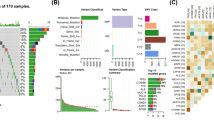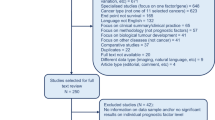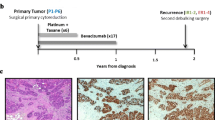Abstract
Purpose
Mutations in the tumor suppressor gene TP53 are associated with a variety of cancers. Therefore, it is important to know the occurrence and prognostic effects of TP53 mutations in certain cancers.
Methods
Over 29,000 cases from the April 2016 release of the International Agency for Research on Cancer (IARC) TP53 Database were analyzed to determine the distribution of germline and somatic mutations in the TP53 gene. Subsequently, 7,893 cancer cases were compiled in cBioPortal for Cancer Genomics from the 33 most recent The Cancer Genome Atlas (TCGA) studies to determine the prevalence of TP53 mutations in cancers and their effects on survival and disease-free survival times.
Results
The data were analyzed, and it was found that the majority of TP53 mutations were missense and the major mutational hotspots were located at codons 248, 273, 175, and 245 in exons 4–8 for somatic mutations with the addition of codon 337 and other mutations in exons 9–10 for germline mutations. Out of 33 TGCA studies, the effects of TP53 mutations were statistically significant in nine cancers (lung adenocarcinoma, hepatocellular carcinoma, head and neck squamous cell carcinoma, acute myeloid leukemia, clear cell renal cell carcinoma (RCC), papillary RCC, chromophobe RCC, uterine endometrial carcinoma, and thymoma) for survival time and in five cancers (pancreatic adenocarcinoma, hepatocellular carcinoma, chromophobe RCC, acute myeloid leukemia, and thymoma) for disease-free survival time. It was also found that the most common p53 mutation in hepatocellular carcinomas (R249S) was a much better indicator for poor prognosis than TP53 mutations as a whole. In addition, in cases of ovarian serous cystadenocarcinoma, the co-occurrence of TP53 and BRCA mutations resulted in longer survival and disease-free survival times than the presence of neither TP53 nor BRCA mutations.
Conclusion
TP53 mutations are potential prognostic markers that can be used to further improve the accuracy of predicting survival and disease-free survival times of cancer patients.










Similar content being viewed by others
References
Alidousty C et al (2018) Genetic instability and recurrent MYC amplification in ALK-translocated NSCLC: a central role of TP53 mutations. J Pathol 246:67–76. https://doi.org/10.1002/path.5110
Bouaoun L, Sonkin D, Ardin M, Hollstein M, Byrnes G, Zavadil J, Olivier M (2016) TP53 variations in human cancers: new lessons from the IARC TP53 database and genomics data. Hum Mutat 37:865–876. https://doi.org/10.1002/humu.23035
Cerami E et al (2012) The cBio cancer genomics portal: an open platform for exploring multidimensional. Cancer Genom Data Cancer Discov 2:401–404. https://doi.org/10.1158/2159-8290.cd-12-0095
Credits (2017) IARC. http://p53.iarc.fr/Credits.aspx. Accessed 1 Sep 2017
Edwards SJ, Hananeia L, Eccles MR, Zhang YF, Braithwaite AW (2003) The proline-rich region of mouse p53 influences transactivation and apoptosis but is largely dispensable for these functions. Oncogene 22:4517–4523
Friedler A, Veprintsev DB, Hansson LO, Fersht AR (2003) Kinetic instability of p53 core domain mutants: implications for rescue by small molecules. J Biol Chem 278:24108–24112. https://doi.org/10.1074/jbc.M302458200
Gao J et al (2013) Integrative analysis of complex cancer genomics and clinical profiles using the cBioPortal. Sci Signal 6:pl1. https://doi.org/10.1126/scisignal.2004088
Harms KL, Chen X (2006) The functional domains in p53 family proteins exhibit both common and distinct properties. Cell Death Differ 13:890–897
Kato S, Han SY, Liu W, Otsuka K, Shibata H, Kanamaru R, Ishioka C (2003) Understanding the function-structure and function-mutation relationships of p53 tumor suppressor protein by high-resolution missense mutation analysis. Proc Natl Acad Sci USA 100:8424–8429. https://doi.org/10.1073/pnas.1431692100
Kim Y, Cho M-Y, Kim J, Kim SN, Oh SC, Lee K-A (2017) Profiling cancer-associated genetic alterations and molecular classification of cancer in Korean gastric cancer patients. Oncotarget 8:69888–69905. https://doi.org/10.18632/oncotarget.19435
Li-Fraumeni syndrome (2017) USA.gov. https://ghr.nlm.nih.gov/condition/li-fraumeni-syndrome#genes. Accessed 23 Aug 2017
Lomax ME, Barnes DM, Gilchrist R, Picksley SM, Varley JM, Camplejohn RS (1997) Two functional assays employed to detect an unusual mutation in the oligomerisation domain of p53 in a Li-Fraumeni like family. Oncogene 14:1869–1874. https://doi.org/10.1038/sj.onc.1201133
Olivier M et al (2006) The clinical value of somatic TP53 gene mutations in 1794 patients with breast cancer. Clin Cancer Res 12:1157
Olivier M, Hollstein M, Hainaut P (2010) TP53 mutations in human cancers: origins, consequences, and clinical use. Cold Spring Harbor Perspect Biol 2:a001008 https://doi.org/10.1101/cshperspect.a001008
Pavletich NP, Chambers KA, Pabo CO (1993) The DNA-binding domain of p53 contains the four conserved regions and the major mutation hot spots. Genes Dev 7:2556–2564
Petitjean A, Mathe E, Kato S, Ishioka C, Tavtigian SV, Hainaut P, Olivier M (2007) Impact of mutant p53 functional properties on TP53 mutation patterns and tumor phenotype: lessons from recent developments in the IARC TP53 database. Hum Mutat 28:622–629. https://doi.org/10.1002/humu.20495
Rich JT, Neely JG, Paniello RC, Voelker CCJ, Nussenbaum B, Wang EW (2010) A practical guide to understanding Kaplan-Meier curves. Otolaryngol Head Neck Surg 143:331–336. https://doi.org/10.1016/j.otohns.2010.05.007
Ross J, Hortobagyi G (2005) Molecular oncology of breast cancer. Jones & Bartlett Learning, Burlington
Salnikova LE (2014) Clinicopathologic characteristics of brain tumors are associated with the presence and patterns of TP53 mutations: evidence from the IARC TP53. Database Neuromol Med 16:431–447. https://doi.org/10.1007/s12017-014-8290-1
The Cancer Genome Atlas Network (2011) Integrated genomic analyses of ovarian carcinoma. Nature 474:609–615. https://doi.org/10.1038/nature10166
The Cancer Genome Atlas Network (2012) Comprehensive genomic characterization of squamous cell lung cancers. Nature 489:519–525. https://doi.org/10.1038/nature11404
Zhu J, Zhang S, Jiang J, Chen X (2000) Definition of the p53 functional domains necessary for inducing apoptosis. J Biol Chem 275:39927–39934. https://doi.org/10.1074/jbc.M005676200
Author information
Authors and Affiliations
Corresponding author
Ethics declarations
Conflict of interest
We declare that we have no conflict of interest.
Ethical approval
This article does not contain any studies with human participants or animals performed by any of the authors.
Rights and permissions
About this article
Cite this article
Li, V.D., Li, K.H. & Li, J.T. TP53 mutations as potential prognostic markers for specific cancers: analysis of data from The Cancer Genome Atlas and the International Agency for Research on Cancer TP53 Database. J Cancer Res Clin Oncol 145, 625–636 (2019). https://doi.org/10.1007/s00432-018-2817-z
Received:
Accepted:
Published:
Issue Date:
DOI: https://doi.org/10.1007/s00432-018-2817-z




